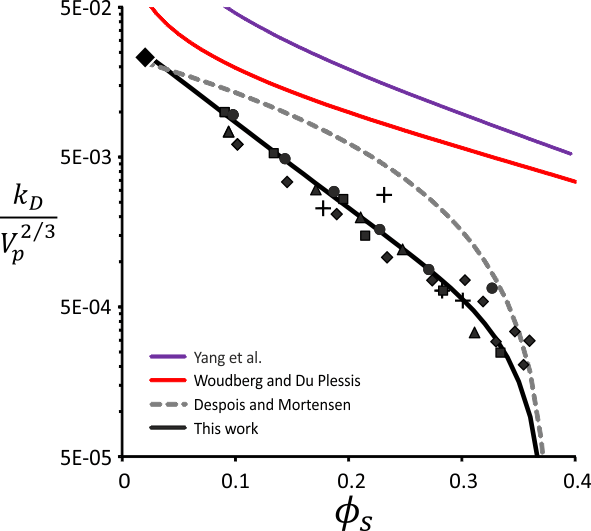Fluid permeability of solid foams is a crucial parameter to control transport phenomena in numerous engineering applications, such as heat exchangers or filters for example. Open-cell foams with monodisperse pore diameter ranging from 200 to 1000 µm and solid volume fraction ranging from 0.1 to 0.38 were produced and Darcy permeability was measured. The permeability divided by the square of the pore size showed an exponential decay as a function of solid volume fraction. Surprisingly, existing models did not capture this exponential decay and actually they predicted permeability values significantly larger than the measured values. The observed exponential decay was then successfully described by using models based on the viscous dissipation occurring through the apertures that connect the foam pores and by accounting for both the mean size of the apertures and the mean number of apertures per pore.

We also studied how the permeability of solid foam is modified by the presence of membranes that close partially or totally the cell windows connecting neighboring pores. The finite element method (FEM) simulations computing the Stokes problem were performed at both pore and macroscopic scales. Pore-network simulation was performed by assuming a local law based on Sampson’s equation, and reproduced very well the FEM results. Then this low computational cost method was used to study in detail the effect of an open window fraction on the percolation properties of the foam pore space. The results clarified the effect of membranes on foam permeability.
Related papers:
– Permeability of monodisperse solid foams, Olivier Pitois, Asmaa Kaddami, Vincent Langlois, Transport in Porous Media 134 (2020) 635–649
– Permeability of solid foam: Effect of pore connections, V. Langlois, V. H. Trinh, C. Lusso, C. Perrot, X. Chateau, Y. Khidas, O. Pitois, Physical Review E 97, 053111 (2018)


